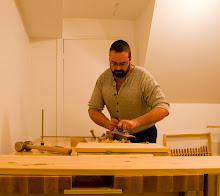The current push in dovetail saws is for the narrowest kerf you can get away with. My dovetail saw has four thousandths of an inch of set, which is a hair less than the thickness of a sheet of copy paper. That's not a lot.
Reworking the Crappy Crown Gent's Saw got me thinking about kerf because when I finished filing it the first time the kerf was still far too wide, I thought.
I did the test cut and the cut was fast, effortless and straight, but it was wider than I wanted.
Now I'm wondering about the effect of kerf on joinery.
Where you have two cuts forming an angle of significantly less than 90 degrees, a wide kerf will give you a poor corner. Either you will have a groove in one kerf wall, or you will have a slightly rounded inside corner. The narrower the kerf the less effect there is.
However, when doing something like a dovetail, the wider the kerf the easier it is to release the waste when chopping it out. The waste won't wedge as easily - you have more room for the chisel.
When cutting in general, the less kerf you have the harder it is to steer the saw, however having too much kerf is a poor choice, as you need to expend too much energy keeping the saw cutting straight.
The minimum amount of kerf is dependant on the wood being sawed, the depth of the saw blade, and desired radius of cut, when cutting curves. Green softwood requires a great deal more kerf than dry hardwood, a panel saw requires more kerf than a bow saw, and a turning saw requires more kerf than a dovetail saw.
I don't know if there is a magical formula out there where you can punch in your requirements and it tells you the proper kerf to use. I suspect most manufacturers just use traditional values as a basis point and modify it as required.
More mulling on this matter is required, but I'm starting to wonder if striving for the narrowest kerf is the correct path.
Tuesday, October 21, 2008
Subscribe to:
Post Comments (Atom)

No comments:
Post a Comment